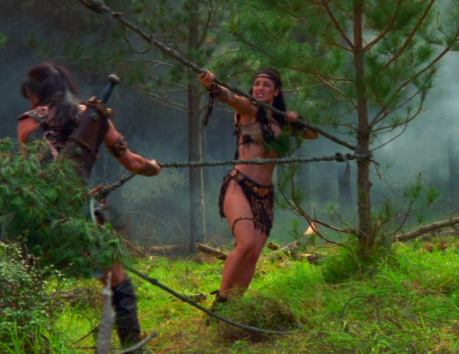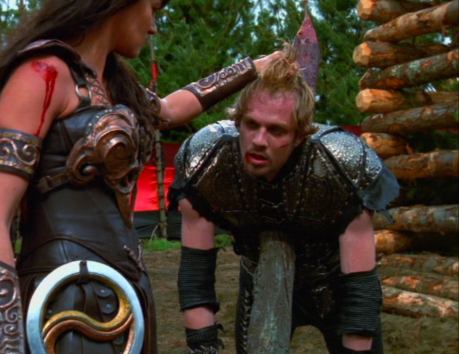| The Eaters of the Dead Norse element connects the Coming Home arc with the three-episode Ring Cycle that follows it. This is Xena's equivalent to Hercules' Norse arc. It combines the Germanic legends of Beowulf and the Ring of the Nibelung, but there's more than that going on. If we consult Eliade's book on shamanism, we'll find that the Valkyrie are shamanic figures, and that Xena is well qualified to best them, since these episodes take place after Adventures in the Sin Trade, chronologically. In the chapter dealing with "Techniques of Ecstasy among the Ancient Germans," right after the section dealing with the ecstatic practices of the berserkirs, it talks about the Norse practice of seidhr, a type of magic practiced by the gods. Odin knew of it, but did not practice it; he learned it from the goddess Freyja, and therefore, Eliade concludes this type of magic was a feminine specialty.01 This practice of seidhr is compared by Eliade to shamanism: specifically, it's a type of "mystical flight" that is present in religious magic throughout the world; we see it here in the Valkyries, in Adventures in the Sin Trade in the climactic battle between Alti and Xena, in Eli's rope trick, in Fallen Angel, and elsewhere, plus we'll see it again later this season.02 Another aspect of shamanic practice is the descent into the underworld, and among the ancient Germans, this was symbolized by crossing a "wall of flame," as we'll see in the final installment of Xena's Ring cycle.03 Xena's rescue of Gabrielle, therefore, should be seen as yet another Orphic journey, a repeat of the Black Orpheus theme. It should be noted, by the way, that in the very paragraph I just quoted is a footnote on the practice of suttee, in which a female servant of the fallen warrior is burned alive on his funeral pyre; we saw that in Between the Lines, and we see its image here in the form of Gabrielle protected by a wall of fire--which signifies her trapped state in the underworld. This footnote mentions Ahmed ibn Fadlan's account of it in his travels among the Scandinavians: this very same person is used by Michael Crichton as the narrator of his version of Beowulf in his Eaters of the Dead. There are other motifs here we've seen before: Grendal is represented here as a kind of tree monster, which we've seen numerous times before, going all the way back to Antaeus in the Hercules movie, Hercules and the Circle of Fire." The idea of beauty turned to ugliness we saw in the final movie, Hercules and the Maze of the Minotaur. The tree demon will, of course, return in the series finale, in the form of Yodoshi, Eater of Souls (whose name may be a play off of Eaters of the Dead). This Ring trilogy is followed by a satyr play, Old Ares Had a Farm. I've already mentioned how mortal Ares is more satyr than man, and he becomes even more so in this episode, since he's no longer able to masquarade as a god. In a satyr play, the relationship between divine and human is reversed, with humans possessing wisdom and power, and triumphing in the end. We'll note here that the relationship between Xena and Gabrielle with Ares isn't really much changed by his loss of divine status; the only thing different is the degree of his bluster. Ares was introduced on Hercules offscreen as a terrifying force, and in The Vanishing Dead, his monstrous Dog of War threatened humanity. Here, his dog has become man's (or satyr's) best friend. Dangerous Prey brings us back to The Bacchae. Prince Morloch is a hunter, like King Penthius, and his prey is the same: he seeks the Stranger, Xena, and his hunting ground is very much like the forests of the bacchae. We'll recall in Athens City Academy of the Performing Bards, how Euripides seemed to be quoting from his play, The Bacchae, in one scene. That quote we deduced is finally portrayed on screen here, as described by King Penthius's messenger below:

 The influence of The Bacchae continues into the next episode, The God You Know, another installment in the Caesar arc. This time, the successor to Augustus, Caligula, is a combination of characters from the play. He has King Penthius's arrogance and the bacchae's ecstatic nature, but unlike Julius Caesar, he lacks the dark cunning of Dionysus; he's outwitted by the woman who represents the true Dionysus, Xena. Caligula has become a god--it's not explained how this happened, and no explanation is needed: in this sense, he shares the nature of the giant in The Cyclops, who declares himself the rival of Zeus on his own authority. Like Odysseus, Xena can't kill him herself, but she can trick him into impaling himself. The title of the episode refers to Xena's favoring the Greek gods over Caligula, but it may also have arisen from The Bacchae: the god you know is better than the god you don't, and certainly, Dionysus as the new god in town is far more dangerous than all the others: likewise, Caligula the God is no match for Xena the Stranger! Path of Vengeance, along with To Helicon and Back complete the Amazon thread for both Xena and Hercules. The leaders of all the Amazon Nations have gathered in Greece to pool their strength, and among them we see an African leader, Mawu, an African goddess (mentioned on p. 45 of Mircea Eliade's Patterns in Comparative Religion in conjunction with the Ewe culture, which I'll focus on more in the religious essay that accompanies this one, "The Center of the World"), Kanae, a Polynesian Amazon (whose name apparently comes from G. Grey's Polynesian Mythology), and Gwynn-Teir, a British Amazon named after the Welsh equivalent of Artemis. The presence of the African and Polynesian Amazons recall E.R. Dodd's observation that "maenadism is alive and well, in Africa and Polynesia, among others," in his book The Greeks and the Irrational. The Northern Amazons arrive as well, led by a new Cyane played by the same actress who played Eris in Kindred Spirits. These Amazons, unlike the others, were survivors of Xena's slaughter, and lack an adult presence. Even though twenty five years have passed since those times, they are still represented by teens. What also makes them stand out is that they are the only Amazons we've seen on the show who carry the famed bow and arrow of the Amazons of Greek myth (who removed a breast in order to fire it). Why these distinctions? Possibly because this episode draws inspiration from the same play by Aristophanes that "Kindred Spirits did: The Thesmophoriazusae. In that play, the guardian of the Women's Festival, called The Scythian, is armed with a quiver--and he makes a pun of that word to describe his own quivering with rage after being tricked from his post by Euripides and his dancing girl accomplice. In Path of Vengeance, the women of the Festival (whose secret society we equated with the Amazons) are combined with the dancing girl and the Scythian when we meet them a quarter of a century later. We see more evidence that The Thesmophoriazusae is being used here in the trial of Eve. Like Euripides' spy, she is sentenced to death, but just like him, she escapes death, by becoming another person. The trial is paralleled by another trial, between Varia and Xena, in which they engage in a long fight sequence; it's like a more serious version of the wrestling match in Kindred Spirits between Xena and Joxer, and the result of both fights to the death is the same: both escape death; in the respective trials of Eve and Joxer, the letter of the law is followed while each life is spared. |